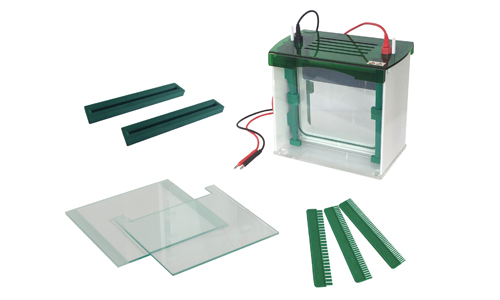Electrophoresis in agarose or polyacrylamide gels is one of the methodologies most used in the laboratory in everything related to working with nucleic acids. Through electrophoresis we can separate DNA and RNA fragments based on their size, visualize them by means of a simple staining, and in this way determine the nucleic acid content of a sample, having an estimate of their concentration.
The gel electrophoresis technique uses the difference in size and charge of different molecules in a sample. The DNA, RNA or protein sample to be separated is loaded attached to a porous gel placed in an ionic environment of the buffer. In the use of electrical charge, each molecule that has different size and charge will move through the gel at different speeds.
The porous gel used in this technique acts as a molecular sieve that separates the larger molecules from the smaller ones. Smaller molecules move faster through the gel while larger ones are left behind. The mobility of the particles is also controlled by their individual electrical charge.
How is gel electrophoresis carried out?
The gel used in gel electrophoresis is generally made of a material called agarose, which is a gelatinous substance extracted from seaweed, or also from polyacrylamide. This porous gel can be used to separate macromolecules of many different sizes. The gel is immersed in a buffer solution in an electrophoresis chamber. Tris-borate-EDTA (TBE) is commonly used as the buffer. Its main function is to control the pH of the system. The chamber has two electrodes – one positive and one negative – at its two ends.
The samples that need to be analyzed are then loaded into tiny wells on the gel with the help of a pipette. Once charging is complete, an electric current of 50-150 V is applied. Now, the charged molecules present in the sample begin to migrate through the gel towards the electrodes. The charged molecules move towards the positive electrode and the charged molecules migrate negative towards the negative electrode.
The speed at which each molecule travels through the gel is called its electrophoretic mobility and is primarily determined by its net charge and size. Strongly charged molecules move faster than weakly charged ones. Smaller molecules run faster leaving behind larger ones. So, strong charge and small size increase the electrophoretic mobility of a molecule, while weak charge and large size decrease the mobility of a molecule.
Once the separation is complete, the gel is colored with a dye to reveal the bands from the separation. Ethidium Bromide is a fluorescent dye commonly used in gel electrophoresis. The gel is soaked in a dilute ethidium bromide solution and then placed in a UV transilluminator to visualize the separation bands. The bands are immediately examined or photographed for future reference, as they will diffuse into the gel over time.
At Kalstein we are MANUFACTURERS and we offer you excellent electrophoresis systems at the best PRICES on the market. That is why we invite you to take a look at the Products menu. HERE


